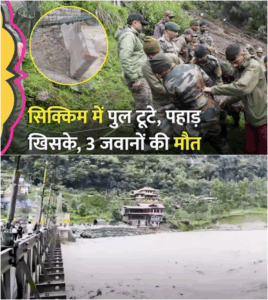Sikkim’s Rainfall Fury: Overflowing Rivers, Collapsing Mountains, and a Race Against Time to Save Lives
Nestled in the lap of the Himalayas, Sikkim is often celebrated for its serene beauty, lush green valleys, and snow-capped peaks. However, in the first week of June 2025, this picturesque state turned into a site of devastation as relentless rainfall wreaked havoc, triggering landslides, flooding rivers, and leaving destruction in its wake. The calamity has claimed the lives of three soldiers, left six others missing, and stranded hundreds of tourists in the region, as rescue teams battle harsh weather and challenging terrains to save as many lives as possible.
This is the story of nature’s fury, human resilience, and the tireless efforts of rescue workers trying to bring hope to a region gripped by despair.
.
.
.

The Beginning of the Disaster: Sikkim’s Torrential Rainfall
On June 1, 2025, Sikkim experienced heavy and continuous rainfall, a natural occurrence in the region during the monsoon season. However, the intensity of the downpour was unprecedented, causing rivers to swell beyond their banks and triggering landslides in the mountainous terrain. The rainfall began to overwhelm the fragile infrastructure of the region, with bridges collapsing, roads being washed away, and entire hillsides crumbling under the weight of the water.
One of the most alarming incidents occurred in the northern part of Sikkim, near the small town of Chatten. A military camp stationed in the area was struck by a massive landslide, burying parts of the camp under tons of mud and debris. The suddenness of the event left little time for the soldiers to react, resulting in tragic fatalities and several personnel going missing.
Tragic Losses: Soldiers Caught in the Landslide
As the rain continued to pour, the military camp in Chatten became a casualty of nature’s fury. On the evening of June 1, at around 7:00 PM, a landslide engulfed the camp, claiming the lives of three brave soldiers and leaving six others unaccounted for. The deceased were identified as Havildar Lakhwinder Singh, Lance Naik Manish Thakur, and porter Abhishek. Their bodies were recovered on June 2, bringing heartbreak to their families and the nation.
The rescue operation, led by the Indian Army and local authorities, has faced numerous challenges due to the treacherous conditions. The mountainous terrain, combined with the relentless rain, has made it difficult for rescue teams to access the affected areas. Despite these obstacles, efforts are ongoing to locate the six missing personnel, with teams working around the clock to comb through the debris.
In addition to the soldiers, four other individuals who sustained minor injuries were rescued and provided medical attention. Their survival amidst the chaos is a testament to the resilience of the human spirit and the determination of the rescue teams.
Tourists Stranded: A Race Against Time
While the landslide in Chatten highlighted the vulnerability of those stationed in the region, the situation for tourists in northern Sikkim was equally dire. Hundreds of tourists, including families with children, found themselves stranded as roads were blocked and bridges collapsed. With no way to return to safety, they were left at the mercy of the elements, relying on local residents and authorities for support.
In the Lachung area, one of the worst-hit regions, over 1,600 tourists were stranded. The district collector of Mangan, Anant Jain, took charge of the rescue operations, coordinating efforts to evacuate the tourists and ensure their safety. By June 2, the first group of tourists was successfully evacuated, bringing a glimmer of hope amidst the despair.
The evacuation process was no small feat. A total of 284 tourist vehicles and 16 motorcycles were used to transport the stranded individuals to safety. This included 737 men, 561 women, and 380 children, all of whom had endured days of uncertainty and fear. The tourists expressed their gratitude to the local authorities and residents, who provided them with food, shelter, and support during the ordeal.
One tourist shared their experience, saying, “We were scared, but the local people and our drivers took care of us. They made sure we had food and stayed safe. We are so thankful to them and the rescue teams for helping us get back home.”
The Challenges of Rescue Operations
Rescue operations in Sikkim have been fraught with difficulties. The heavy rain has not only caused landslides but also made it nearly impossible for teams to access remote areas. Roads leading to the affected regions have been washed away, and the continuous threat of further landslides has put rescue workers at risk.
The Indian Army, local police, and disaster management teams have been working tirelessly to overcome these challenges. Helicopters have been deployed to airlift stranded individuals from areas that are inaccessible by road. In some cases, rescue teams have had to trek through treacherous terrain to reach those in need.
Despite the risks, the rescuers remain determined to save as many lives as possible. Their efforts are a testament to the strength of the human spirit in the face of adversity.
The Aftermath: A Community in Mourning
As the rain begins to subside, the true extent of the damage is becoming apparent. Villages have been destroyed, livelihoods have been lost, and families are grieving the loss of their loved ones. The people of Sikkim are no strangers to the challenges posed by their rugged environment, but the scale of this disaster has left even the most resilient among them shaken.
For the families of the soldiers who lost their lives, the pain is immeasurable. These brave men made the ultimate sacrifice while serving their country, and their loss is a stark reminder of the dangers faced by those stationed in remote and challenging locations.
The local administration is working to provide relief to those affected by the disaster. Temporary shelters have been set up for displaced residents, and efforts are underway to restore essential services such as electricity and clean water. However, the road to recovery will be long and arduous.
A Call for Preparedness
The disaster in Sikkim serves as a stark reminder of the need for better disaster preparedness and infrastructure in vulnerable regions. While the state has made significant strides in recent years, the challenges posed by its geography and climate require continuous efforts to minimize the impact of natural disasters.
Experts have called for improved early warning systems, better road maintenance, and increased investment in disaster response capabilities. These measures can help save lives and reduce the impact of future calamities.
Play video:
Conclusion: Resilience in the Face of Adversity
The recent rainfall and landslides in Sikkim have tested the resilience of its people, but they have also highlighted the strength of the human spirit. From the bravery of the soldiers who gave their lives to the tireless efforts of the rescue teams, this disaster has shown that even in the darkest of times, hope and humanity prevail.
As the people of Sikkim begin the long journey toward recovery, they do so with the support of the entire nation. Their story is one of courage, determination, and the unyielding belief that brighter days lie ahead.
News
Missing PG Student Monica from Darbhanga CM College Found in Shocking Condition—Police Stunned
Missing Darbhanga CM College Student Monica Found Safe—Reveals She Left Home Willingly to Marry A week-long mystery surrounding the disappearance…
Chaos on the Kanwar Yatra: Devotees Go on Rampage, Vandalize Dhaba from Muzaffarnagar to Roorkee!
Kanwar Yatra Turns Violent: Kanwariyas Vandalize Dhabas from Muzaffarnagar to Roorkee Over Onion in Food A shocking wave of violence…
Uproar After Samajwadi Party Leader Sunil Yadav’s Death: Ex-MLA and Brother-in-Law Named in FIR!
Uproar in Sultanpur After Samajwadi Party Leader Sunil Yadav’s Mysterious Death: Former MLA and Brother-in-Law Named in FIR A wave…
Shocking Viral Video: Teacher Beats Student with Stick in Bihar School—Discipline or Violence?
Bihar School Turns Battleground: Viral Video Shows Teacher Beaten Brutally by Angry Parents—Discipline or Violence? A shocking video has taken…
Forced to Strip at Knifepoint: Obscenity in the Name of Jobs—What’s Happening in Uttar Pradesh?
Job Promise Turns Nightmare: Woman Forced to Undress at Knifepoint in Uttar Pradesh Official’s Quarters Uttar Pradesh: A shocking video…
UP Education Minister Injured in Road Accident as Convoy Cars Collide
UP Education Minister Gulab Devi Injured in Road Accident as Convoy Cars Collide Hapur, Uttar Pradesh: Uttar Pradesh’s Education Minister,…
End of content
No more pages to load












